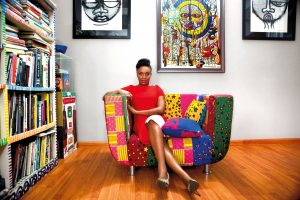“When we reject the single story. When we realize that there is never a single story about any place. We regain a kind of paradise.” – Chimananda Ngozi Adichie
 This is the last phrase of Chimamanda Adichie’s excellent TED talk about the danger of a single story. Although the TED talk was given in 2009, its message, specially about immigrants, is stronger today. Chimamanda, a Nigerian author, encourages us to avoid single stories (having one single perspective or narrative of a person, community or country) and learn about our peers thoroughly and holistically. She grew up near higher education institutions because her parents were faculty at the University of Nigeria in Nsukka, and continued to be close to universities throughout her education. She began her undergrad in Drexel University, then transferred to Eastern Connecticut State University. She did her master’s degree at John Hopkins University, followed by a second masters from Yale University. Additionally, she was awarded fellowships from both Princeton and Harvard Universities.
This is the last phrase of Chimamanda Adichie’s excellent TED talk about the danger of a single story. Although the TED talk was given in 2009, its message, specially about immigrants, is stronger today. Chimamanda, a Nigerian author, encourages us to avoid single stories (having one single perspective or narrative of a person, community or country) and learn about our peers thoroughly and holistically. She grew up near higher education institutions because her parents were faculty at the University of Nigeria in Nsukka, and continued to be close to universities throughout her education. She began her undergrad in Drexel University, then transferred to Eastern Connecticut State University. She did her master’s degree at John Hopkins University, followed by a second masters from Yale University. Additionally, she was awarded fellowships from both Princeton and Harvard Universities.
Higher education is present in her novels as well. Her characters range from academics in the heart of planning revolutions, to Nigerian immigrants facing the challenges of American higher education, both as students and as immigrants. Through her storytelling, the readers are given another perspective of what it means to study in the United States and what international students face when entering a new academic system while getting used to a different culture. In between lines, she highlights the importance of diversity in universities and how international students enhance the educational experience.
Universities are spaces where the danger of a single story can be eliminated. As Chimamanda’s experience meeting her undergrad roommate who had a single story about Africans, cultural and friendship exchanges can help bridge cultural perceptions and share knowledge. After reading her novels, being an international student myself and coming from a Mexican University with only 5% international students, I question: How can diversity of students and nationalities be encouraged in universities? What type of activities can students and faculty do to avoid the danger of a single story? What are other advantages of having international students in higher education institutions?
Here is the link to the TED talk: https://www.ted.com/talks/chimamanda_adichie_the_danger_of_a_single_story
Novels by Chimamanda N. Adichie:
Half of a Yellow Sun, Purple Hibiscus, Americanah
